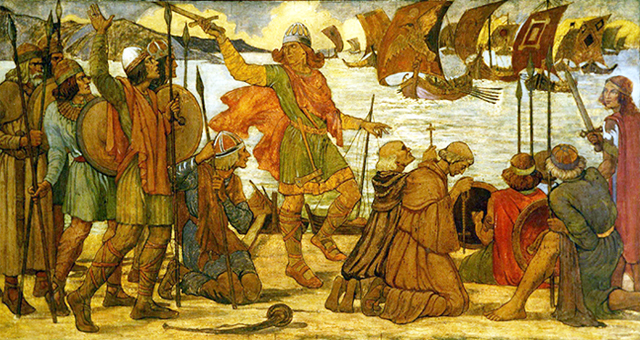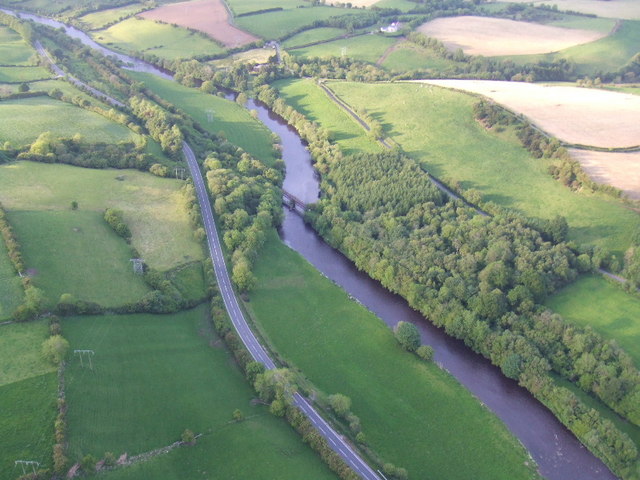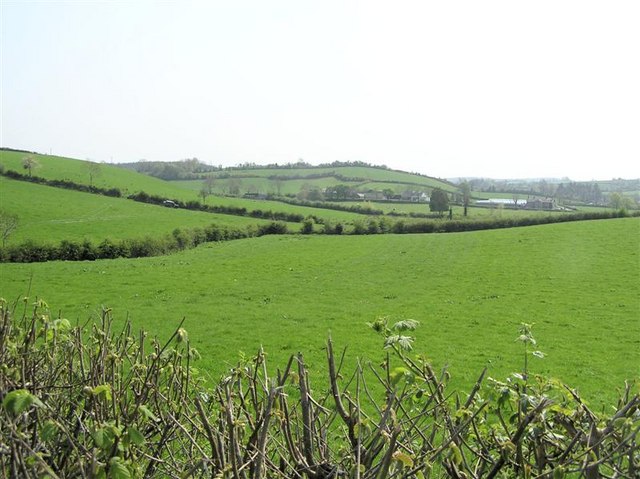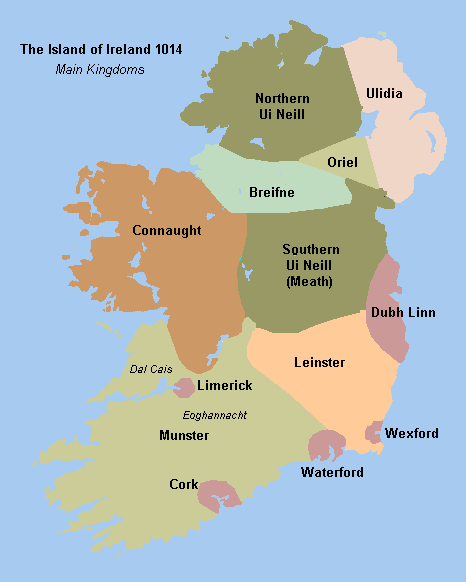|
Cenél Lugdach
;List of Irish Clans in the province of Ulster Northern Uí Néill Niall of the Nine Hostages had seven sons, two of which, Eógan mac Néill, Owen (Eoghan) and Conall Gulban (Conaill) traveled north from the over-kingdom of Connacht and into the northern and western regions of the over-kingdom of Ulster, an area equivalent to modern-day County Donegal. These two became the progenitors of the two Cenél's (or kindreds) that would make up the Northern Uí Néill; the Cenél Eóghain based in Inishowen, with their capital at Ailech; and the Cenél Conaill centered in the rich area of Magh Ithe, in the valley of the river Finn. For a time the Cenél Eóghain and Cenél Conaill alternated as kings of the Northern Uí Néill until the 8th century. The Northern Uí Néill would also alternate the High-Kingship of Ireland with their southern cousins the Southern Uí Néill into the 10th century. Cenél nEóghain Cenél Conaill Cianachta The Cianachta, or the race of Kane, also ... [...More Info...] [...Related Items...] OR: [Wikipedia] [Google] [Baidu] |
Irish Clans
Irish clans are traditional kinship groups sharing a common surname and heritage and existing in a lineage-based society, originating prior to the 17th century. A clan (or in Irish, plural ) included the chief and his Patrilineality, patrilineal relatives; however, Irish clans also included unrelated clients of the chief. These unrelated clients and their agnatic descendants were ineligible to be elected chief, but nonetheless assumed the name of the leading lineage as a show of allegiance. Beginning in the 8th century, various genealogical collections were compiled purporting to trace the ancestry of these clans. Among them are genealogies in Bodleian_Library,_MS_Rawlinson_B_502, Rawlinson B 502, the Book of Ballymote, the Great_Book_of_Lecan, Book of Lecan, the Leabhar_na_nGenealach, ''Leabhar Mór na nGenealach'' compiled by Dubhaltach MacFhirbisigh, and the Ó Cléirigh Book of Genealogies. In all of these cases, the genealogies listed state the agnatic descent of the chiefs ... [...More Info...] [...Related Items...] OR: [Wikipedia] [Google] [Baidu] |
Colla Uais
The Three Collas (Modern Irish: ''Trí Cholla'') were, according to medieval Irish legend and historical tradition, the fourth-century sons of Eochaid Doimlén, son of Cairbre Lifechair. Their names were: Cairell Colla Uais; Muiredach Colla Fo Chrí (also spelt Colla da Chrioch, or Fochrich); and Áed Colla Menn. Colla Uais ruled as High King of Ireland for four years. Recent DNA analysis confirms the history of the Three Collas in fourth-century Ireland, but questions their descent from Eochaid Doimlén and Cairbre Lifechair. Legend According to tradition, the Three Collas killed their uncle, Fíacha Sroiptine, at the Battle of Dubhchomar, in Crioch Rois, Breagh, with Colla Uais taking the kingship. It was prophesied that whoever killed them, his descendants would never rule Ireland. Colla Uais ruled in Fíacha's place for three years (323-326 AD), and as High-King of Ireland for four years, until Fiacha's son Muiredach Tirech banished the Three Collas, exiling them and three hu ... [...More Info...] [...Related Items...] OR: [Wikipedia] [Google] [Baidu] |
County Dublin
County Dublin ( or ) is a Counties of Ireland, county in Republic of Ireland, Ireland, and holds its capital city, Dublin. It is located on the island's east coast, within the Provinces of Ireland, province of Leinster. Until 1994, County Dublin (excluding the city) was a single Local government in the Republic of Ireland, local government area; in that year, the county council was divided into three new administrative counties: Dún Laoghaire–Rathdown, Fingal and South Dublin. The three administrative counties together with Dublin City proper form a NUTS III NUTS statistical regions of Ireland, statistical region of Ireland (coded IE061). County Dublin remains a single administrative unit for the purposes of the courts (including the Dublin County Sheriff, but excluding the bailiwick of the Dublin City Sheriff) and Dublin County combined with Dublin City forms the Judicial County of Dublin, including Dublin Circuit Court, the Dublin County Registrar and the Dublin Metropolitan ... [...More Info...] [...Related Items...] OR: [Wikipedia] [Google] [Baidu] |
County Tyrone
County Tyrone (; ) is one of the six counties of Northern Ireland, one of the nine counties of Ulster and one of the thirty-two traditional counties of Ireland. Its county town is Omagh. Adjoined to the south-west shore of Lough Neagh, the county covers an area of , making it the largest of Northern Ireland's six counties by size, and the second largest county in Ulster after Donegal. With a population of 188,383 as of the 2021 census, Tyrone is the 5th most populous county in both Northern Ireland and Ulster, and the 11th most populous county on the island of Ireland. The county derives its name and general geographic location from Tír Eoghain, a Gaelic kingdom under the O'Neill dynasty which existed until the 17th century. Name The name ''Tyrone'' is derived from the Irish , meaning 'land of Eoghan', the name given to the conquests made by the from the provinces of and Ulaid. Historically, it was anglicised as ''Tirowen'' or ''Tyrowen'', which are closer to the Irish ... [...More Info...] [...Related Items...] OR: [Wikipedia] [Google] [Baidu] |
County Monaghan
County Monaghan ( ; ) is a Counties of Ireland, county in Ireland. It is in the Provinces of Ireland, province of Ulster and is part of Border Region, Border strategic planning area of the Northern and Western Region. It is named after the town of Monaghan. Monaghan County Council is the Local government in the Republic of Ireland, local authority for the county. The population of the county was 65,288, according to the 2022 census. The county has existed since 1585 when the Mac Mathghamhna rulers of Airgíalla agreed to join the Kingdom of Ireland. Following the 20th-century Irish War of Independence and the signing of the Anglo-Irish Treaty, Monaghan was one of three Ulster counties to join the Irish Free State rather than Northern Ireland. Geography and subdivisions County Monaghan is the fifth-smallest of the Republic's 26 counties by area, and the fourth smallest by population. It is the smallest of Ulster's nine counties in terms of population. Baronies * Cremorne (ba ... [...More Info...] [...Related Items...] OR: [Wikipedia] [Google] [Baidu] |
County Londonderry
County Londonderry (Ulster Scots dialects, Ulster-Scots: ''Coontie Lunnonderrie''), also known as County Derry (), is one of the six Counties of Northern Ireland, counties of Northern Ireland, one of the thirty-two Counties of Ireland, counties of Ireland and one of the nine counties of Ulster. Before the partition of Ireland, it was one of the Counties of Ireland, counties of the Kingdom of Ireland from 1613 onward and then of the United Kingdom after the Acts of Union 1800. Adjoining the north-west shore of Lough Neagh, the county covers an area of and today has a population of about 252,231. Since 1972, the counties in Northern Ireland, including Londonderry, have no longer been used by the state as part of the local administration. Following further reforms in 2015, the area is now governed under three different districts: Derry and Strabane, Causeway Coast and Glens and Mid-Ulster District, Mid-Ulster. Despite no longer being used for local government and administrative ... [...More Info...] [...Related Items...] OR: [Wikipedia] [Google] [Baidu] |
County Armagh
County Armagh ( ) is one of the six counties of Northern Ireland and one of the traditional thirty-two counties of Ireland. It is located in the Provinces of Ireland, province of Ulster and adjoins the southern shore of Lough Neagh. It borders the Northern Irish counties of County Tyrone, Tyrone to the west and County Down, Down to the east. The county borders County Louth, Louth and County Monaghan, Monaghan to the south and southwest, which are in the Republic of Ireland. It is named after its county town, Armagh, which derives from the Irish language, Irish ''Ard Mhacha'', meaning "Macha's height". Macha was a sovereignty goddess in Irish mythology and is said to have been buried on a wooded hill around which the town of Armagh grew. County Armagh is colloquially known as the "Orchard County" because of its many apple orchards. The county covers an area of , making it the smallest of Northern Ireland's six counties by size and the List of Irish counties by area, sixth-smallest ... [...More Info...] [...Related Items...] OR: [Wikipedia] [Google] [Baidu] |
Bréifne
The Kingdom of Breifne or Bréifne (), anglicized as Breffny, was a medieval overkingdom in Gaelic Ireland. It comprised what is now County Leitrim, County Cavan and parts of neighbouring counties, and corresponds roughly to the Roman Catholic Diocese of Kilmore. It had emerged by the 10th century, as a confederation of ' headed by an overking drawn from the Uí Briúin Bréifne. By the 11th century, Bréifne was ruled by the Ua Ruairc (O'Rourke) dynasty. The kingdom reached the height of its power in the 12th century, under Tigernán Ua Ruairc. During the latter part of his reign, Bréifne took part in campaigns against the Norman invasion of Ireland. His assassination by the Anglo-Normans in 1172 was followed by a succession dispute, and a conflict between the Ua Ruairc and Ua Raghallaigh (O'Reilly) dynasties. Following the Battle of Magh Slecht in 1256, Bréifne split into West Breifne (ruled by the Ua Ruairc) and East Breifne (ruled by the Ua Raghallaigh). Bréifn ... [...More Info...] [...Related Items...] OR: [Wikipedia] [Google] [Baidu] |
Uí Briúin
The Uí Briúin were a royal dynasty of Connacht. Their eponymous apical ancestor was Brión, son of Eochaid Mugmedon and Mongfind, and an elder half brother of Niall of the Nine Hostages. They formed part of the Connachta, along with the Uí Fiachrach and Uí Ailello, putative descendants of Eochaid Mugmedon's sons Fiachra and Ailill. The Uí Ailello were later replaced as the third of the Three Connachta, through genealogical sleight of hand, by the Uí Maine. History Connacht was ruled in early times by the Uí Fiachrach, the Uí Briúin only becoming the dominant force in Connacht in the 7th and 8th centuries. The Uí Briúin divided into multiple septs, the three major ones being: * The Uí Briúin Aí, named for the region they controlled—Mag nAí, the lands around the ancient centre of Connacht, Cruachan in modern County Roscommon. The most notable sept of the Uí Briúin Ai was the Síol Muireadaigh, from whom the ruling families of Ó Conchubhair ... [...More Info...] [...Related Items...] OR: [Wikipedia] [Google] [Baidu] |
County Fermanagh
County Fermanagh ( ; ) is one of the thirty-two counties of Ireland, one of the nine counties of Ulster and one of six counties of Northern Ireland. The county covers an area of and had a population of 63,585 as of 2021. Enniskillen is the county town and largest in both size and population. Fermanagh is one of four counties of Northern Ireland to have a majority of its population from a Catholic background, according to the 2011 census. Geography Fermanagh spans an area of 1,851 km2 (715 sq; mi), accounting for 13.2% of the landmass of Northern Ireland. Nearly a third of the county is covered by lakes and waterways, including Upper and Lower Lough Erne and the River Erne. Forests cover 14% of the landmass (42,000 hectares). It is the only county in Northern Ireland that does not border Lough Neagh. The county has three prominent upland areas: * the expansive West Fermanagh Scarplands to the southwest of Lough Erne, which rise to about 350m, * the Sl ... [...More Info...] [...Related Items...] OR: [Wikipedia] [Google] [Baidu] |
Barony Of Lurg
Lurg () is a barony situated in the north of County Fermanagh, Northern Ireland. To its south lies Lower Lough Erne, and it is bordered by four other baronies in Northern Ireland: Magheraboy to the south; Tirkennedy to the south-east; Omagh West to the north; and Omagh East to the east. It also borders to the west the barony of Tirhugh in the Republic of Ireland. History The barony of Lurg is based on the ancient Irish territory of ''Tuath Luirg'', also known as ''Fir Luirg'' (the men of Lurg), who are claimed to be genealogically related to the Airgialla. This territory was the patrimonial inheritance of the O'Muldoon (). It is listed in the Annals, under the name ''Lorg'', as being a kingdom in the year 1039. Prior to this, Lurg was the base of the O'Monaghan (), thought to be descended from the original inhabitants of the area, the ''Fir Manach'', from which County Fermanagh gets its name. According to 19th century genealogist John O'Hart, the barony was also home to the Mu ... [...More Info...] [...Related Items...] OR: [Wikipedia] [Google] [Baidu] |
Dál Riata
Dál Riata or Dál Riada (also Dalriada) () was a Gaels, Gaelic Monarchy, kingdom that encompassed the Inner Hebrides, western seaboard of Scotland and north-eastern Ireland, on each side of the North Channel (Great Britain and Ireland), North Channel. At its height in the 6th and 7th centuries, it covered what is now Argyll ("Coast of the Gaels") in Scotland and part of County Antrim in Northern Ireland.Clancy, Thomas Owen, "Philosopher King: Nechtan mac Der Ilei," SHR 83 (2004): 135–149 After a period of expansion, Dál Riata eventually became associated with the Gaelic Kingdom of Alba.''Oxford Companion to Scottish History'' pp. 161–162, edited by Michael Lynch, Oxford University Press. . In Argyll, it consisted of four main clan, kindreds or tribes, each with their own chief: the Cenél nGabráin (based in Kintyre), the Cenél nÓengusa (based on Islay), the Loarn mac Eirc, Cenél Loairn (who gave their name to the district of Lorne, Scotland, Lorn) and the Cenél Comgai ... [...More Info...] [...Related Items...] OR: [Wikipedia] [Google] [Baidu] |









